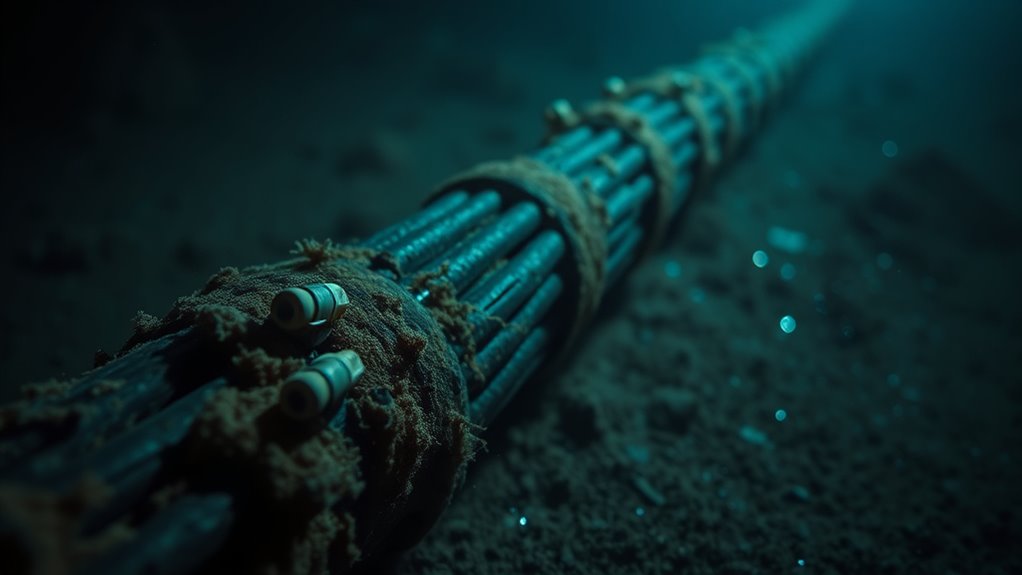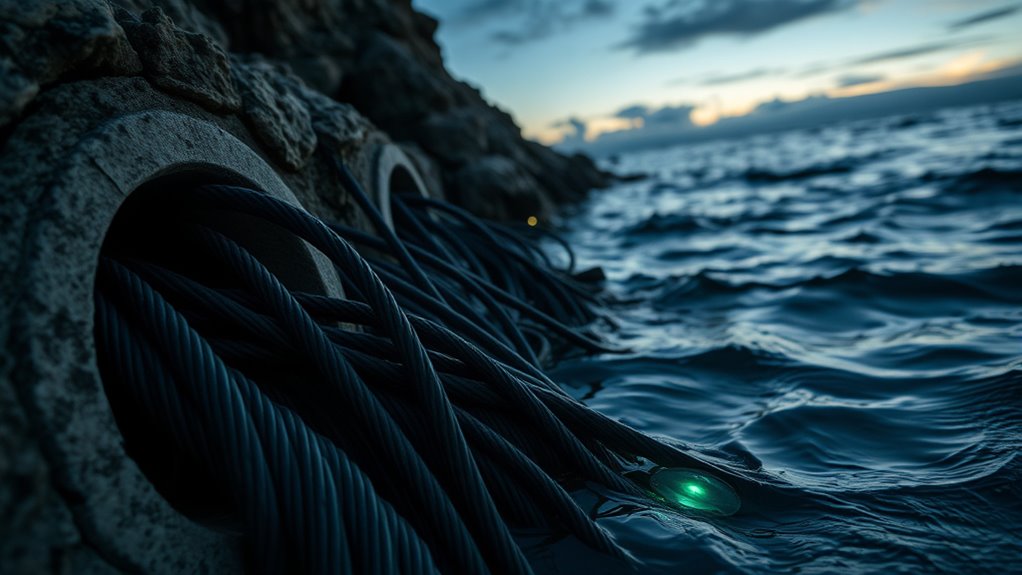Undersea cables form a essential part of global communication, carrying over 99% of international data. Spies often target these cables with covert devices that intercept light signals, gathering sensitive information without detection. These tiny, discreet devices are embedded within the cable’s structure and operated remotely to avoid suspicion. As technology advances, so do espionage techniques, making this undersea battleground increasingly significant. If you’re curious, understanding the evolving tactics to protect these critical links reveals a hidden world of technological espionage.
Key Takeaways
- Undersea fiber optic cables are vital for global data transfer and are prime targets for espionage due to their strategic importance.
- Sophisticated tapping devices can discreetly intercept data by attaching micro-scale sensors to the cables’ protective layers.
- Modern espionage techniques involve remote-controlled, stealthy interception methods that are difficult to detect and counter.
- Security measures must continually evolve to address advanced interception technologies and protect critical international communications.
- Tapping undersea cables poses significant risks to diplomatic, corporate, and personal data, highlighting the need for enhanced security efforts.

Undersea cables are the backbone of global communication, carrying over 99% of international data traffic. These essential links connect continents, enabling everything from financial transactions to private messages. But their importance also makes them prime targets for espionage. When you consider the threat landscape, it’s clear that tapping into these cables isn’t just about physical access; sophisticated methods like fiber optic espionage have transformed how spies intercept data. Instead of traditional wiretapping, modern espionage relies heavily on cable tapping technology that exploits the very fiber optic fibers that transmit your information.
Fiber optic espionage involves inserting specialized devices into the cables to secretly harvest data as it flows through. Unlike older copper wire tapping, fiber optic cables are more challenging to intercept because they transmit data as pulses of light within glass fibers. However, espionage efforts have adapted. Tapping into these cables often means deploying micro-scale devices that can be attached to the cable’s exterior or embedded within protective layers without causing damage. These devices siphon off a small fraction of the light signals, converting them back into usable data for intelligence agencies. It’s a stealthy process, requiring precision engineering and advanced cable tapping technology that minimizes the risk of detection.
Micro-scale devices discreetly tap fiber optic cables, harvesting data without detection.
The technology used in fiber optic espionage has evolved alongside the cables themselves. Modern cable tapping tools are highly sophisticated, enabling spies to access vast quantities of data without alerting the cable operators or security systems. These devices can be remotely controlled, allowing operatives to extract information over extended periods. The covert nature of this operation means you might never know your data is being monitored until it’s too late. Governments and private entities worry about this form of espionage because it can expose sensitive diplomatic communications, corporate secrets, or personal data, all without leaving a trace. As the complexity of these devices increases, so does the need for advanced security measures to safeguard critical infrastructure. Additionally, the development of new interception techniques continues to challenge existing security protocols.
As global reliance on undersea cables grows, so does the incentive for covert interception. The development of more advanced cable tapping technology makes it easier for spies to conduct fiber optic espionage covertly. This ongoing arms race highlights the importance of securing these critical links against unauthorized access. While physical security measures are in place, the most significant vulnerabilities now lie in the technological domain, where sophisticated tapping devices can be discreetly attached or embedded. Understanding these risks underscores the need for continuous innovation in cable security and surveillance countermeasures to protect the integrity of international communications from unseen threats lurking beneath the ocean’s surface.
Frequently Asked Questions
How Do Spies Physically Access Undersea Cables Without Detection?
You might wonder how spies physically access undersea cables without detection. They use covert insertion techniques, often deploying specialized equipment to avoid alarms. Stealth equipment allows them to cut or tap into the cables discreetly, sometimes at remote or less monitored locations. They rely on careful planning, minimal disturbances, and quick operations to evade detection, making it a highly secretive and risky endeavor.
What Countries Are Most Involved in Undersea Cable Espionage?
You should know that countries like the US, China, Russia, and the UK are heavily involved in undersea cable espionage. They engage in global espionage and cyber intelligence to intercept data, monitor communications, and gather strategic information. These nations invest in advanced technology to tap into or monitor undersea cables, making them key players in this covert battleground. Their efforts considerably influence international security and digital diplomacy.
How Do Authorities Detect Cable Tapping Activities?
You can detect cable tapping activities by monitoring fiber optic vulnerabilities and identifying unusual signal interception techniques. Authorities use specialized equipment to analyze signal integrity, looking for anomalies that suggest tampering. They also conduct physical inspections and deploy advanced sensors along the cables. By staying vigilant for subtle changes in signal strength or quality, they can spot potential tapping attempts early, preventing data breaches and safeguarding critical communications.
What Technological Methods Are Used to Intercept Data Secretly?
Imagine your data flowing like a river, vulnerable to unseen hands. Authorities use fiber optic interception and signal tapping to secretly access this flow. They insert sophisticated devices or use advanced cyber techniques to intercept signals without detection. These methods allow spies to listen in on sensitive communications, turning the digital currents into a silent battleground. Your information’s safety depends on how well these covert techniques stay hidden from prying eyes.
Are There International Laws Regulating Undersea Cable Surveillance?
You might wonder if international laws regulate undersea cable surveillance. While there are some legal frameworks and international agreements aimed at protecting undersea infrastructure, enforcement remains challenging. Countries often operate covertly, making it hard to hold violators accountable. You should stay informed about how these agreements attempt to balance security needs with legal restrictions, but realize that surveillance still often falls into a legal gray area, complicating international cooperation.
Conclusion
Now, picture those shimmering undersea highways stretching across the ocean floor, silently carrying your emails, calls, and data. Beneath the waves, unseen eyes might be listening, turning the ocean’s silent depths into a battleground of secrets. As you surf the web or send a message, remember these hidden tunnels are both crucial and vulnerable. The next time you think of your digital world, imagine the quiet war happening beneath the waves, shaping your connected future.









